SME Marketing Environment Analysis: Timboon Fine Ice Creams Case Study
VerifiedAdded on 2023/05/31
|14
|3522
|384
Report
AI Summary
This report provides a comprehensive marketing environment analysis of Timboon Fine Ice Creams, an Australian SME. It includes an industry analysis, examining trends and competition within the Australian ice cream market. The report delves into the microenvironment, analyzing buyer behavior, company strengths and weaknesses, and key competitors like Peters Ice Cream. A SWOT analysis summarizes the company's position, highlighting opportunities for growth and expansion into international markets. The marketing mix (5 P's) of Timboon is discussed, and the report concludes with insights into the company's business growth strategies and target market.
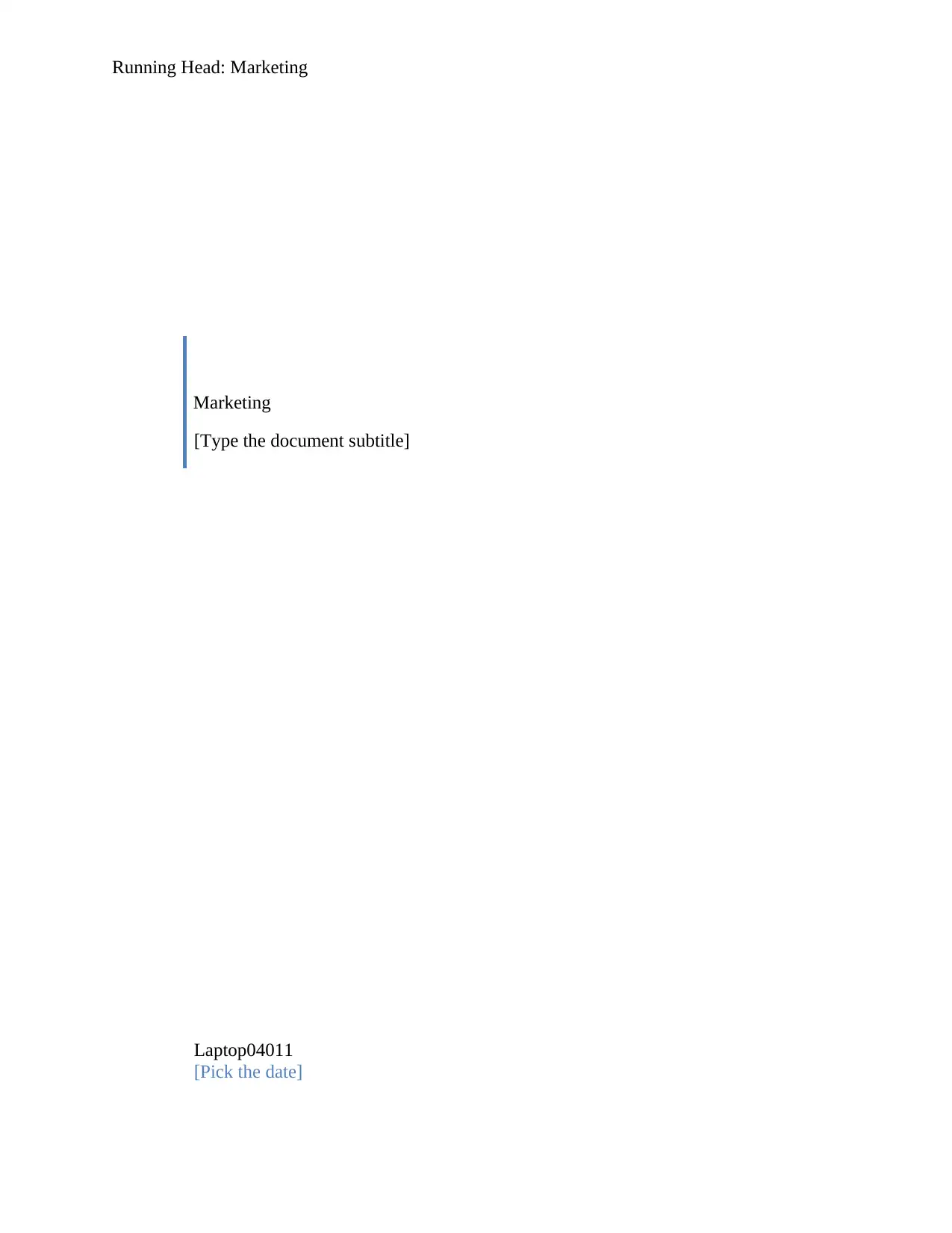
Running Head: Marketing
Marketing
[Type the document subtitle]
Laptop04011
[Pick the date]
Marketing
[Type the document subtitle]
Laptop04011
[Pick the date]
Paraphrase This Document
Need a fresh take? Get an instant paraphrase of this document with our AI Paraphraser
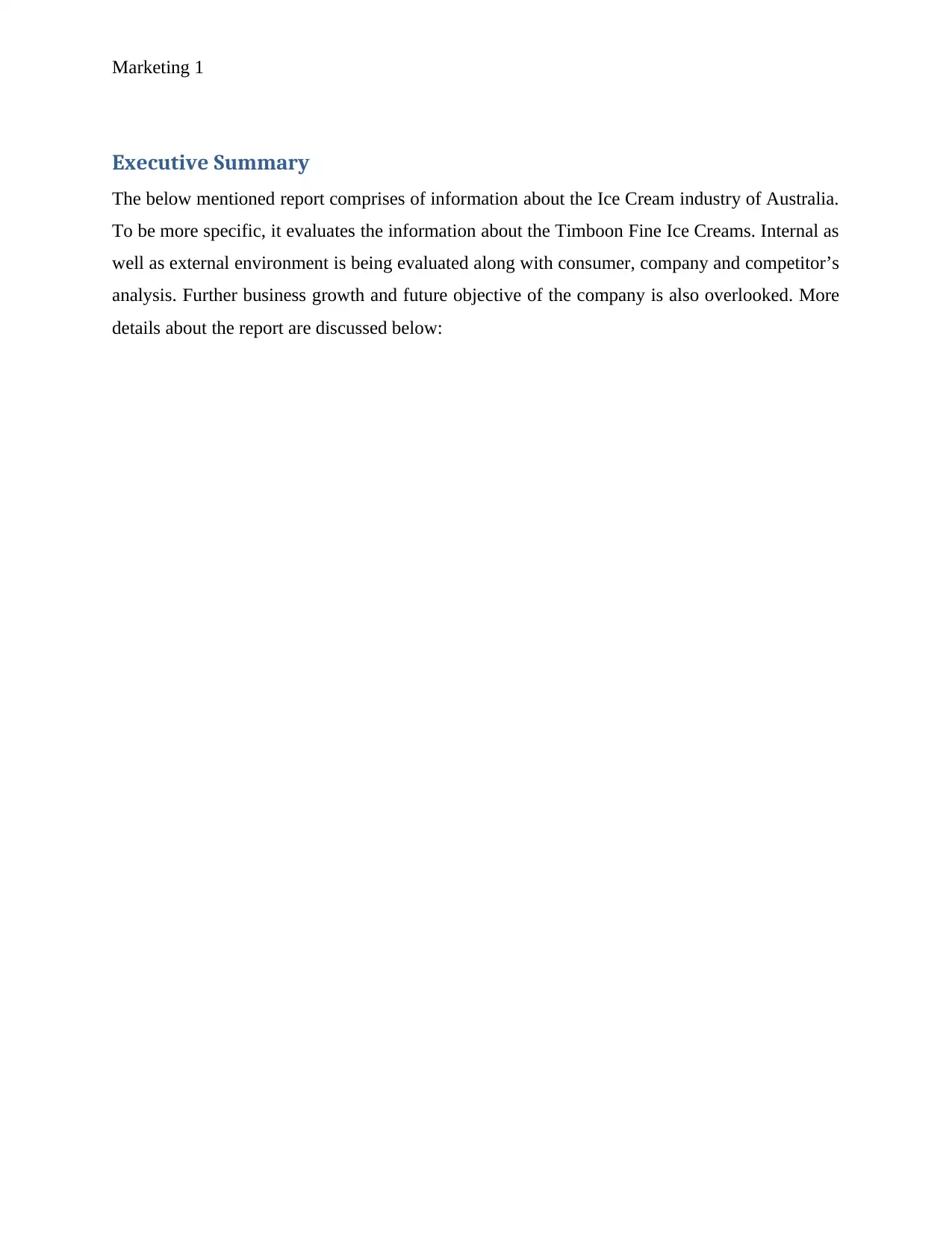
Marketing 1
Executive Summary
The below mentioned report comprises of information about the Ice Cream industry of Australia.
To be more specific, it evaluates the information about the Timboon Fine Ice Creams. Internal as
well as external environment is being evaluated along with consumer, company and competitor’s
analysis. Further business growth and future objective of the company is also overlooked. More
details about the report are discussed below:
Executive Summary
The below mentioned report comprises of information about the Ice Cream industry of Australia.
To be more specific, it evaluates the information about the Timboon Fine Ice Creams. Internal as
well as external environment is being evaluated along with consumer, company and competitor’s
analysis. Further business growth and future objective of the company is also overlooked. More
details about the report are discussed below:
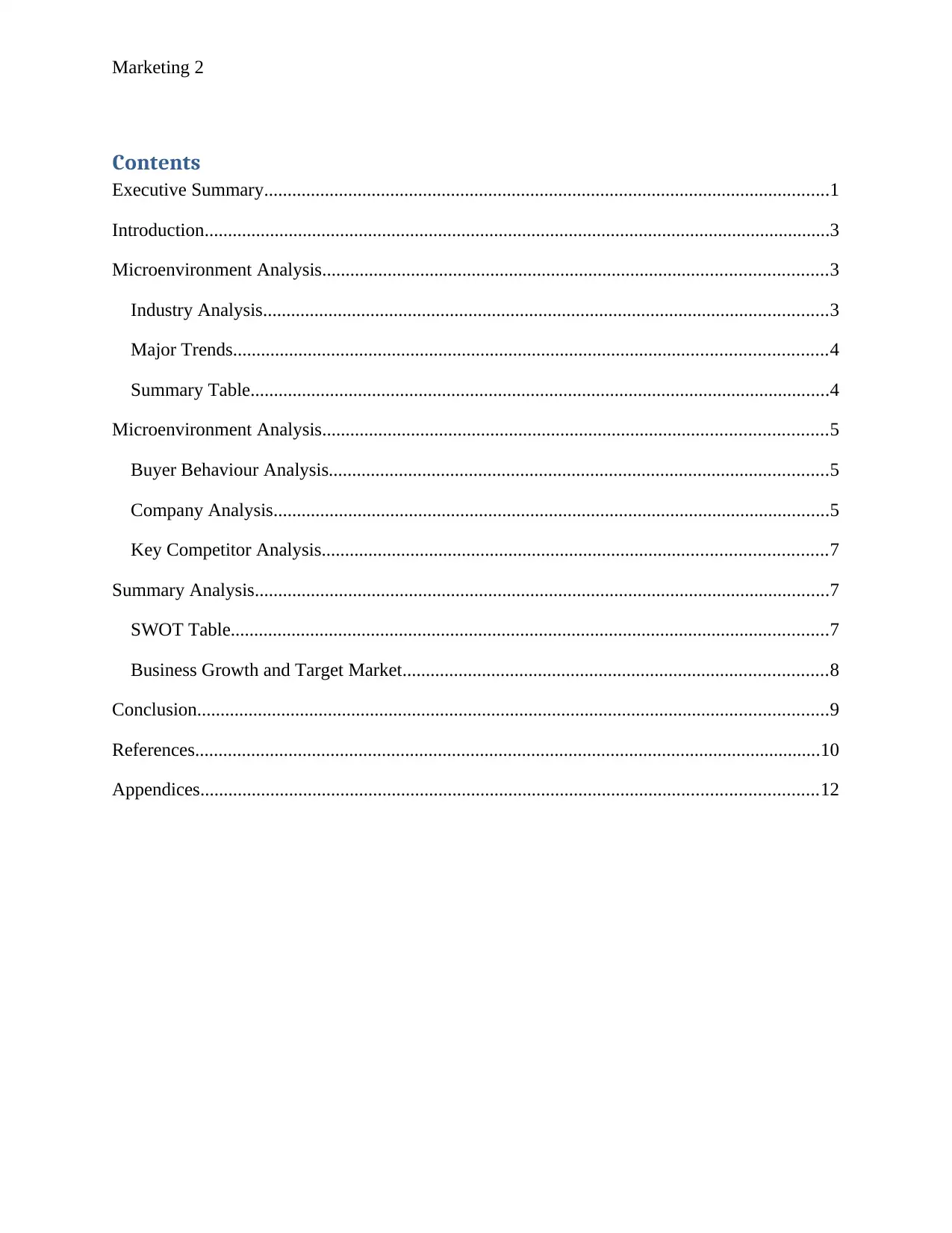
Marketing 2
Contents
Executive Summary.........................................................................................................................1
Introduction......................................................................................................................................3
Microenvironment Analysis............................................................................................................3
Industry Analysis.........................................................................................................................3
Major Trends...............................................................................................................................4
Summary Table............................................................................................................................4
Microenvironment Analysis............................................................................................................5
Buyer Behaviour Analysis...........................................................................................................5
Company Analysis.......................................................................................................................5
Key Competitor Analysis............................................................................................................7
Summary Analysis...........................................................................................................................7
SWOT Table................................................................................................................................7
Business Growth and Target Market...........................................................................................8
Conclusion.......................................................................................................................................9
References......................................................................................................................................10
Appendices....................................................................................................................................12
Contents
Executive Summary.........................................................................................................................1
Introduction......................................................................................................................................3
Microenvironment Analysis............................................................................................................3
Industry Analysis.........................................................................................................................3
Major Trends...............................................................................................................................4
Summary Table............................................................................................................................4
Microenvironment Analysis............................................................................................................5
Buyer Behaviour Analysis...........................................................................................................5
Company Analysis.......................................................................................................................5
Key Competitor Analysis............................................................................................................7
Summary Analysis...........................................................................................................................7
SWOT Table................................................................................................................................7
Business Growth and Target Market...........................................................................................8
Conclusion.......................................................................................................................................9
References......................................................................................................................................10
Appendices....................................................................................................................................12
⊘ This is a preview!⊘
Do you want full access?
Subscribe today to unlock all pages.

Trusted by 1+ million students worldwide
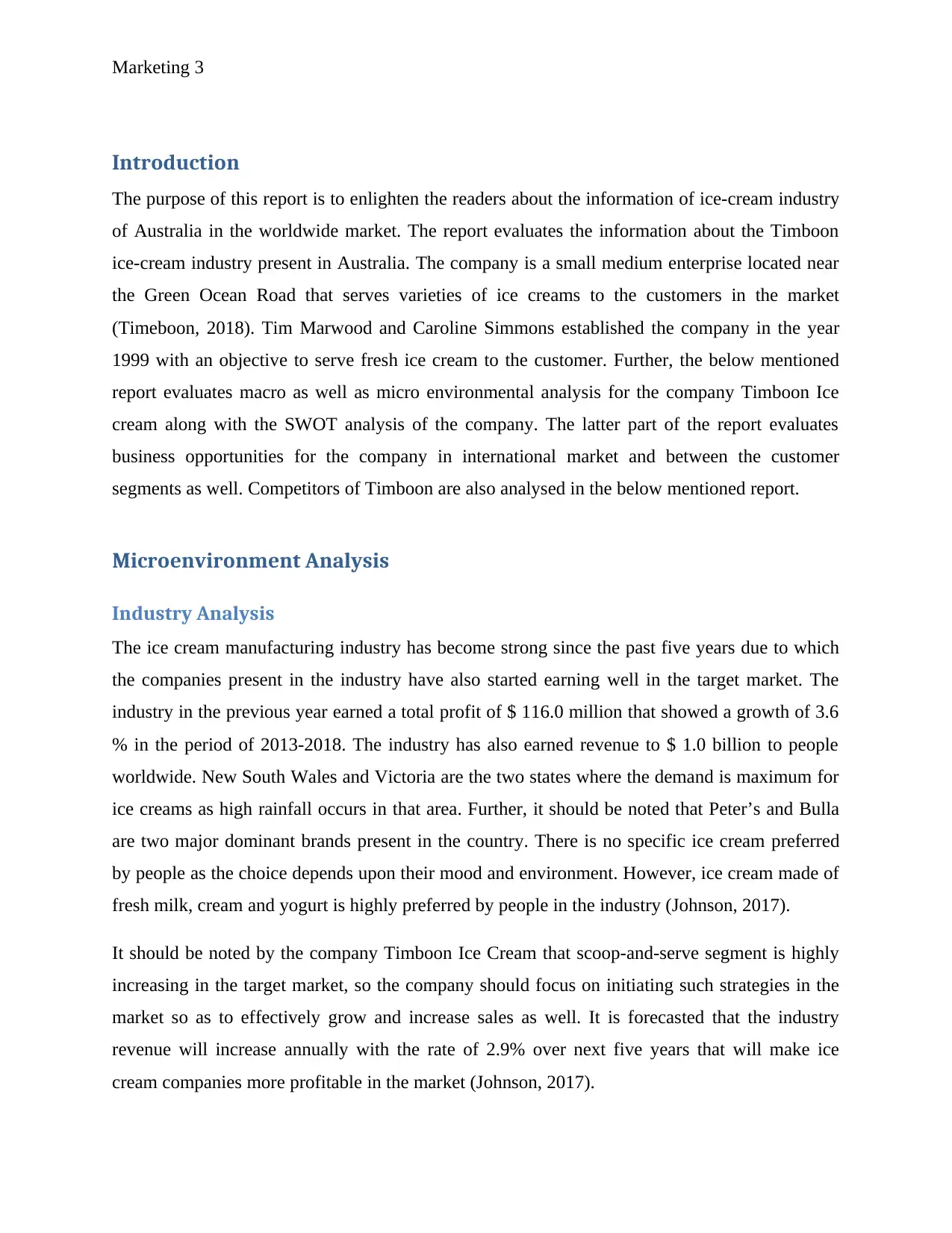
Marketing 3
Introduction
The purpose of this report is to enlighten the readers about the information of ice-cream industry
of Australia in the worldwide market. The report evaluates the information about the Timboon
ice-cream industry present in Australia. The company is a small medium enterprise located near
the Green Ocean Road that serves varieties of ice creams to the customers in the market
(Timeboon, 2018). Tim Marwood and Caroline Simmons established the company in the year
1999 with an objective to serve fresh ice cream to the customer. Further, the below mentioned
report evaluates macro as well as micro environmental analysis for the company Timboon Ice
cream along with the SWOT analysis of the company. The latter part of the report evaluates
business opportunities for the company in international market and between the customer
segments as well. Competitors of Timboon are also analysed in the below mentioned report.
Microenvironment Analysis
Industry Analysis
The ice cream manufacturing industry has become strong since the past five years due to which
the companies present in the industry have also started earning well in the target market. The
industry in the previous year earned a total profit of $ 116.0 million that showed a growth of 3.6
% in the period of 2013-2018. The industry has also earned revenue to $ 1.0 billion to people
worldwide. New South Wales and Victoria are the two states where the demand is maximum for
ice creams as high rainfall occurs in that area. Further, it should be noted that Peter’s and Bulla
are two major dominant brands present in the country. There is no specific ice cream preferred
by people as the choice depends upon their mood and environment. However, ice cream made of
fresh milk, cream and yogurt is highly preferred by people in the industry (Johnson, 2017).
It should be noted by the company Timboon Ice Cream that scoop-and-serve segment is highly
increasing in the target market, so the company should focus on initiating such strategies in the
market so as to effectively grow and increase sales as well. It is forecasted that the industry
revenue will increase annually with the rate of 2.9% over next five years that will make ice
cream companies more profitable in the market (Johnson, 2017).
Introduction
The purpose of this report is to enlighten the readers about the information of ice-cream industry
of Australia in the worldwide market. The report evaluates the information about the Timboon
ice-cream industry present in Australia. The company is a small medium enterprise located near
the Green Ocean Road that serves varieties of ice creams to the customers in the market
(Timeboon, 2018). Tim Marwood and Caroline Simmons established the company in the year
1999 with an objective to serve fresh ice cream to the customer. Further, the below mentioned
report evaluates macro as well as micro environmental analysis for the company Timboon Ice
cream along with the SWOT analysis of the company. The latter part of the report evaluates
business opportunities for the company in international market and between the customer
segments as well. Competitors of Timboon are also analysed in the below mentioned report.
Microenvironment Analysis
Industry Analysis
The ice cream manufacturing industry has become strong since the past five years due to which
the companies present in the industry have also started earning well in the target market. The
industry in the previous year earned a total profit of $ 116.0 million that showed a growth of 3.6
% in the period of 2013-2018. The industry has also earned revenue to $ 1.0 billion to people
worldwide. New South Wales and Victoria are the two states where the demand is maximum for
ice creams as high rainfall occurs in that area. Further, it should be noted that Peter’s and Bulla
are two major dominant brands present in the country. There is no specific ice cream preferred
by people as the choice depends upon their mood and environment. However, ice cream made of
fresh milk, cream and yogurt is highly preferred by people in the industry (Johnson, 2017).
It should be noted by the company Timboon Ice Cream that scoop-and-serve segment is highly
increasing in the target market, so the company should focus on initiating such strategies in the
market so as to effectively grow and increase sales as well. It is forecasted that the industry
revenue will increase annually with the rate of 2.9% over next five years that will make ice
cream companies more profitable in the market (Johnson, 2017).
Paraphrase This Document
Need a fresh take? Get an instant paraphrase of this document with our AI Paraphraser
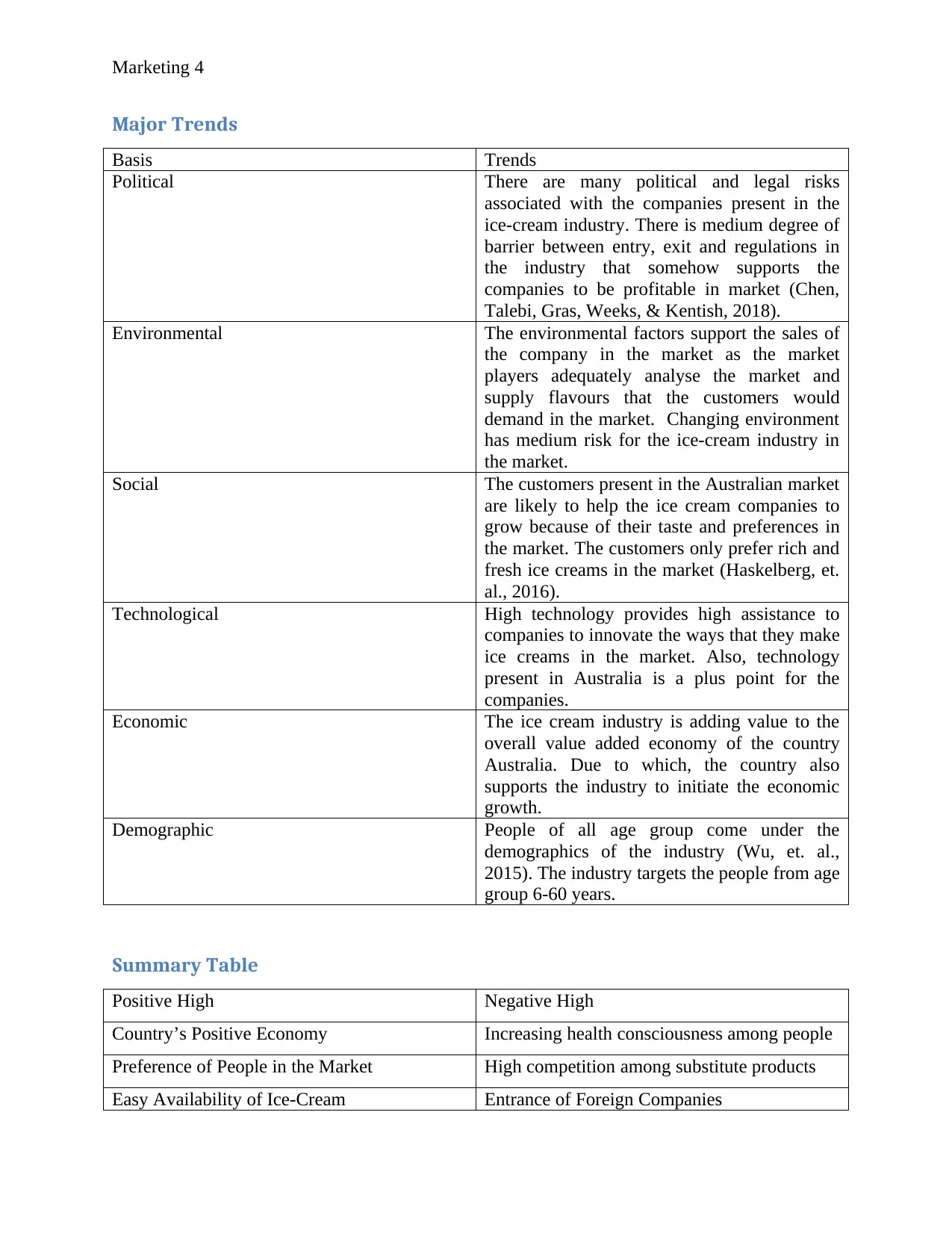
Marketing 4
Major Trends
Basis Trends
Political There are many political and legal risks
associated with the companies present in the
ice-cream industry. There is medium degree of
barrier between entry, exit and regulations in
the industry that somehow supports the
companies to be profitable in market (Chen,
Talebi, Gras, Weeks, & Kentish, 2018).
Environmental The environmental factors support the sales of
the company in the market as the market
players adequately analyse the market and
supply flavours that the customers would
demand in the market. Changing environment
has medium risk for the ice-cream industry in
the market.
Social The customers present in the Australian market
are likely to help the ice cream companies to
grow because of their taste and preferences in
the market. The customers only prefer rich and
fresh ice creams in the market (Haskelberg, et.
al., 2016).
Technological High technology provides high assistance to
companies to innovate the ways that they make
ice creams in the market. Also, technology
present in Australia is a plus point for the
companies.
Economic The ice cream industry is adding value to the
overall value added economy of the country
Australia. Due to which, the country also
supports the industry to initiate the economic
growth.
Demographic People of all age group come under the
demographics of the industry (Wu, et. al.,
2015). The industry targets the people from age
group 6-60 years.
Summary Table
Positive High Negative High
Country’s Positive Economy Increasing health consciousness among people
Preference of People in the Market High competition among substitute products
Easy Availability of Ice-Cream Entrance of Foreign Companies
Major Trends
Basis Trends
Political There are many political and legal risks
associated with the companies present in the
ice-cream industry. There is medium degree of
barrier between entry, exit and regulations in
the industry that somehow supports the
companies to be profitable in market (Chen,
Talebi, Gras, Weeks, & Kentish, 2018).
Environmental The environmental factors support the sales of
the company in the market as the market
players adequately analyse the market and
supply flavours that the customers would
demand in the market. Changing environment
has medium risk for the ice-cream industry in
the market.
Social The customers present in the Australian market
are likely to help the ice cream companies to
grow because of their taste and preferences in
the market. The customers only prefer rich and
fresh ice creams in the market (Haskelberg, et.
al., 2016).
Technological High technology provides high assistance to
companies to innovate the ways that they make
ice creams in the market. Also, technology
present in Australia is a plus point for the
companies.
Economic The ice cream industry is adding value to the
overall value added economy of the country
Australia. Due to which, the country also
supports the industry to initiate the economic
growth.
Demographic People of all age group come under the
demographics of the industry (Wu, et. al.,
2015). The industry targets the people from age
group 6-60 years.
Summary Table
Positive High Negative High
Country’s Positive Economy Increasing health consciousness among people
Preference of People in the Market High competition among substitute products
Easy Availability of Ice-Cream Entrance of Foreign Companies
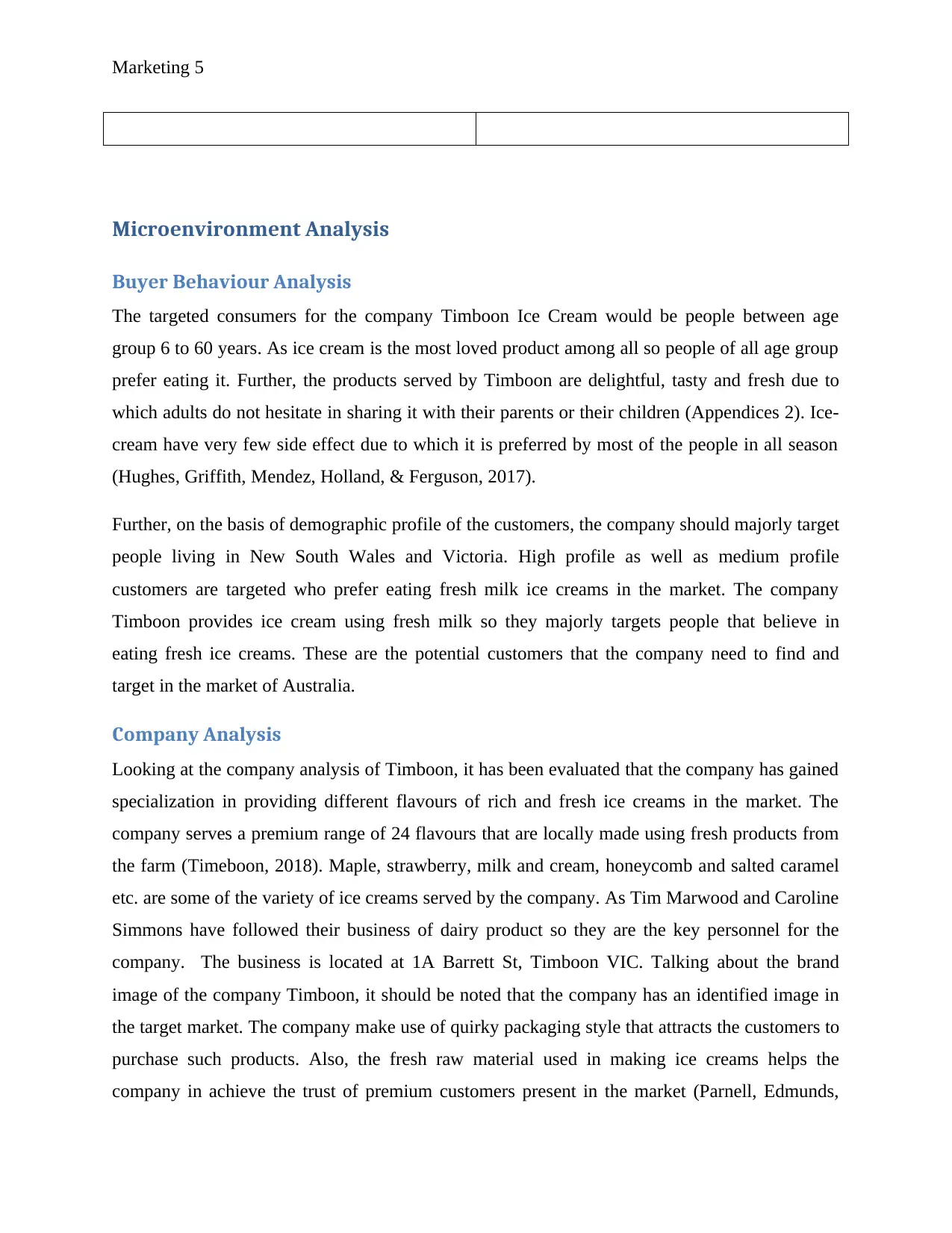
Marketing 5
Microenvironment Analysis
Buyer Behaviour Analysis
The targeted consumers for the company Timboon Ice Cream would be people between age
group 6 to 60 years. As ice cream is the most loved product among all so people of all age group
prefer eating it. Further, the products served by Timboon are delightful, tasty and fresh due to
which adults do not hesitate in sharing it with their parents or their children (Appendices 2). Ice-
cream have very few side effect due to which it is preferred by most of the people in all season
(Hughes, Griffith, Mendez, Holland, & Ferguson, 2017).
Further, on the basis of demographic profile of the customers, the company should majorly target
people living in New South Wales and Victoria. High profile as well as medium profile
customers are targeted who prefer eating fresh milk ice creams in the market. The company
Timboon provides ice cream using fresh milk so they majorly targets people that believe in
eating fresh ice creams. These are the potential customers that the company need to find and
target in the market of Australia.
Company Analysis
Looking at the company analysis of Timboon, it has been evaluated that the company has gained
specialization in providing different flavours of rich and fresh ice creams in the market. The
company serves a premium range of 24 flavours that are locally made using fresh products from
the farm (Timeboon, 2018). Maple, strawberry, milk and cream, honeycomb and salted caramel
etc. are some of the variety of ice creams served by the company. As Tim Marwood and Caroline
Simmons have followed their business of dairy product so they are the key personnel for the
company. The business is located at 1A Barrett St, Timboon VIC. Talking about the brand
image of the company Timboon, it should be noted that the company has an identified image in
the target market. The company make use of quirky packaging style that attracts the customers to
purchase such products. Also, the fresh raw material used in making ice creams helps the
company in achieve the trust of premium customers present in the market (Parnell, Edmunds,
Microenvironment Analysis
Buyer Behaviour Analysis
The targeted consumers for the company Timboon Ice Cream would be people between age
group 6 to 60 years. As ice cream is the most loved product among all so people of all age group
prefer eating it. Further, the products served by Timboon are delightful, tasty and fresh due to
which adults do not hesitate in sharing it with their parents or their children (Appendices 2). Ice-
cream have very few side effect due to which it is preferred by most of the people in all season
(Hughes, Griffith, Mendez, Holland, & Ferguson, 2017).
Further, on the basis of demographic profile of the customers, the company should majorly target
people living in New South Wales and Victoria. High profile as well as medium profile
customers are targeted who prefer eating fresh milk ice creams in the market. The company
Timboon provides ice cream using fresh milk so they majorly targets people that believe in
eating fresh ice creams. These are the potential customers that the company need to find and
target in the market of Australia.
Company Analysis
Looking at the company analysis of Timboon, it has been evaluated that the company has gained
specialization in providing different flavours of rich and fresh ice creams in the market. The
company serves a premium range of 24 flavours that are locally made using fresh products from
the farm (Timeboon, 2018). Maple, strawberry, milk and cream, honeycomb and salted caramel
etc. are some of the variety of ice creams served by the company. As Tim Marwood and Caroline
Simmons have followed their business of dairy product so they are the key personnel for the
company. The business is located at 1A Barrett St, Timboon VIC. Talking about the brand
image of the company Timboon, it should be noted that the company has an identified image in
the target market. The company make use of quirky packaging style that attracts the customers to
purchase such products. Also, the fresh raw material used in making ice creams helps the
company in achieve the trust of premium customers present in the market (Parnell, Edmunds,
⊘ This is a preview!⊘
Do you want full access?
Subscribe today to unlock all pages.

Trusted by 1+ million students worldwide
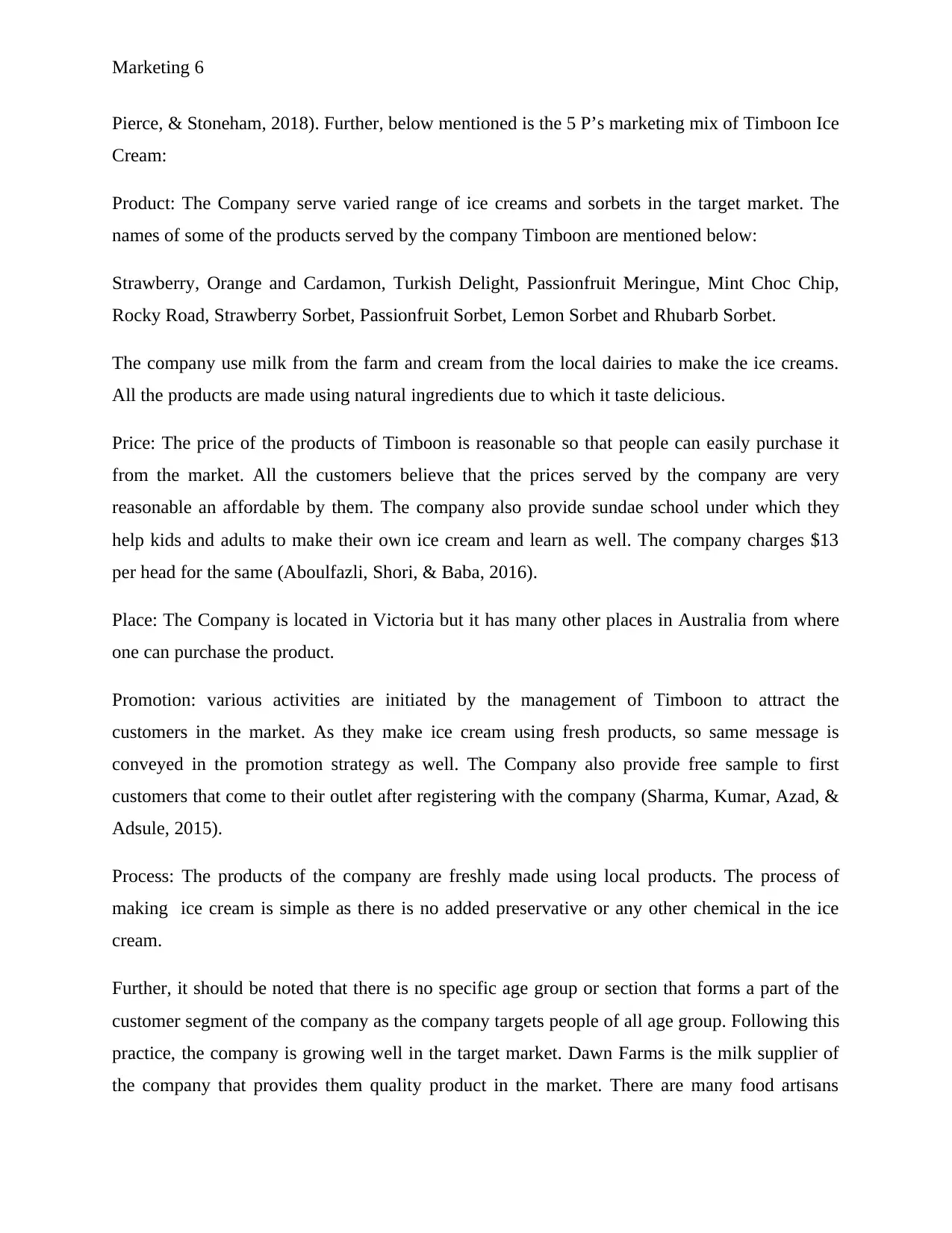
Marketing 6
Pierce, & Stoneham, 2018). Further, below mentioned is the 5 P’s marketing mix of Timboon Ice
Cream:
Product: The Company serve varied range of ice creams and sorbets in the target market. The
names of some of the products served by the company Timboon are mentioned below:
Strawberry, Orange and Cardamon, Turkish Delight, Passionfruit Meringue, Mint Choc Chip,
Rocky Road, Strawberry Sorbet, Passionfruit Sorbet, Lemon Sorbet and Rhubarb Sorbet.
The company use milk from the farm and cream from the local dairies to make the ice creams.
All the products are made using natural ingredients due to which it taste delicious.
Price: The price of the products of Timboon is reasonable so that people can easily purchase it
from the market. All the customers believe that the prices served by the company are very
reasonable an affordable by them. The company also provide sundae school under which they
help kids and adults to make their own ice cream and learn as well. The company charges $13
per head for the same (Aboulfazli, Shori, & Baba, 2016).
Place: The Company is located in Victoria but it has many other places in Australia from where
one can purchase the product.
Promotion: various activities are initiated by the management of Timboon to attract the
customers in the market. As they make ice cream using fresh products, so same message is
conveyed in the promotion strategy as well. The Company also provide free sample to first
customers that come to their outlet after registering with the company (Sharma, Kumar, Azad, &
Adsule, 2015).
Process: The products of the company are freshly made using local products. The process of
making ice cream is simple as there is no added preservative or any other chemical in the ice
cream.
Further, it should be noted that there is no specific age group or section that forms a part of the
customer segment of the company as the company targets people of all age group. Following this
practice, the company is growing well in the target market. Dawn Farms is the milk supplier of
the company that provides them quality product in the market. There are many food artisans
Pierce, & Stoneham, 2018). Further, below mentioned is the 5 P’s marketing mix of Timboon Ice
Cream:
Product: The Company serve varied range of ice creams and sorbets in the target market. The
names of some of the products served by the company Timboon are mentioned below:
Strawberry, Orange and Cardamon, Turkish Delight, Passionfruit Meringue, Mint Choc Chip,
Rocky Road, Strawberry Sorbet, Passionfruit Sorbet, Lemon Sorbet and Rhubarb Sorbet.
The company use milk from the farm and cream from the local dairies to make the ice creams.
All the products are made using natural ingredients due to which it taste delicious.
Price: The price of the products of Timboon is reasonable so that people can easily purchase it
from the market. All the customers believe that the prices served by the company are very
reasonable an affordable by them. The company also provide sundae school under which they
help kids and adults to make their own ice cream and learn as well. The company charges $13
per head for the same (Aboulfazli, Shori, & Baba, 2016).
Place: The Company is located in Victoria but it has many other places in Australia from where
one can purchase the product.
Promotion: various activities are initiated by the management of Timboon to attract the
customers in the market. As they make ice cream using fresh products, so same message is
conveyed in the promotion strategy as well. The Company also provide free sample to first
customers that come to their outlet after registering with the company (Sharma, Kumar, Azad, &
Adsule, 2015).
Process: The products of the company are freshly made using local products. The process of
making ice cream is simple as there is no added preservative or any other chemical in the ice
cream.
Further, it should be noted that there is no specific age group or section that forms a part of the
customer segment of the company as the company targets people of all age group. Following this
practice, the company is growing well in the target market. Dawn Farms is the milk supplier of
the company that provides them quality product in the market. There are many food artisans
Paraphrase This Document
Need a fresh take? Get an instant paraphrase of this document with our AI Paraphraser
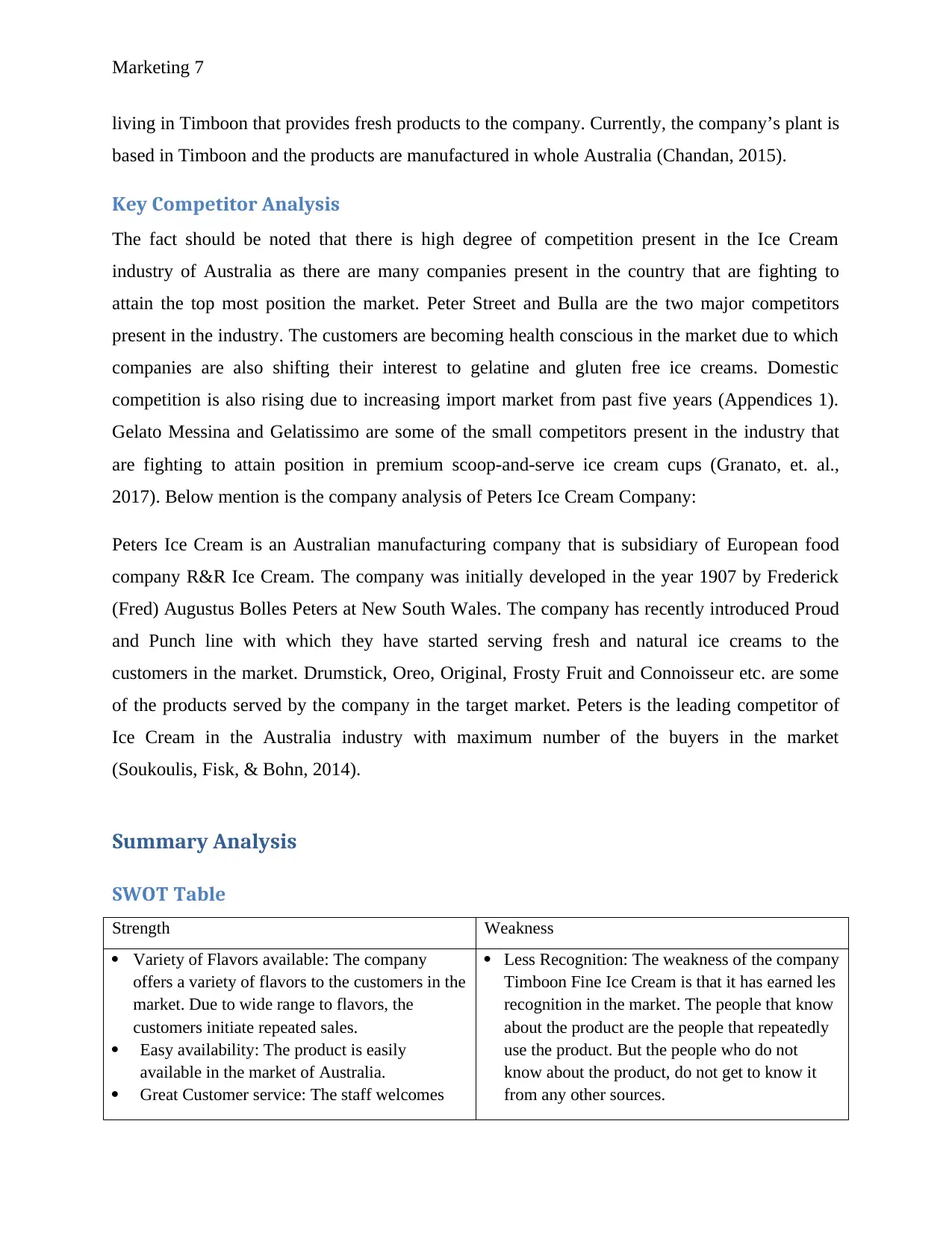
Marketing 7
living in Timboon that provides fresh products to the company. Currently, the company’s plant is
based in Timboon and the products are manufactured in whole Australia (Chandan, 2015).
Key Competitor Analysis
The fact should be noted that there is high degree of competition present in the Ice Cream
industry of Australia as there are many companies present in the country that are fighting to
attain the top most position the market. Peter Street and Bulla are the two major competitors
present in the industry. The customers are becoming health conscious in the market due to which
companies are also shifting their interest to gelatine and gluten free ice creams. Domestic
competition is also rising due to increasing import market from past five years (Appendices 1).
Gelato Messina and Gelatissimo are some of the small competitors present in the industry that
are fighting to attain position in premium scoop-and-serve ice cream cups (Granato, et. al.,
2017). Below mention is the company analysis of Peters Ice Cream Company:
Peters Ice Cream is an Australian manufacturing company that is subsidiary of European food
company R&R Ice Cream. The company was initially developed in the year 1907 by Frederick
(Fred) Augustus Bolles Peters at New South Wales. The company has recently introduced Proud
and Punch line with which they have started serving fresh and natural ice creams to the
customers in the market. Drumstick, Oreo, Original, Frosty Fruit and Connoisseur etc. are some
of the products served by the company in the target market. Peters is the leading competitor of
Ice Cream in the Australia industry with maximum number of the buyers in the market
(Soukoulis, Fisk, & Bohn, 2014).
Summary Analysis
SWOT Table
Strength Weakness
Variety of Flavors available: The company
offers a variety of flavors to the customers in the
market. Due to wide range to flavors, the
customers initiate repeated sales.
Easy availability: The product is easily
available in the market of Australia.
Great Customer service: The staff welcomes
Less Recognition: The weakness of the company
Timboon Fine Ice Cream is that it has earned les
recognition in the market. The people that know
about the product are the people that repeatedly
use the product. But the people who do not
know about the product, do not get to know it
from any other sources.
living in Timboon that provides fresh products to the company. Currently, the company’s plant is
based in Timboon and the products are manufactured in whole Australia (Chandan, 2015).
Key Competitor Analysis
The fact should be noted that there is high degree of competition present in the Ice Cream
industry of Australia as there are many companies present in the country that are fighting to
attain the top most position the market. Peter Street and Bulla are the two major competitors
present in the industry. The customers are becoming health conscious in the market due to which
companies are also shifting their interest to gelatine and gluten free ice creams. Domestic
competition is also rising due to increasing import market from past five years (Appendices 1).
Gelato Messina and Gelatissimo are some of the small competitors present in the industry that
are fighting to attain position in premium scoop-and-serve ice cream cups (Granato, et. al.,
2017). Below mention is the company analysis of Peters Ice Cream Company:
Peters Ice Cream is an Australian manufacturing company that is subsidiary of European food
company R&R Ice Cream. The company was initially developed in the year 1907 by Frederick
(Fred) Augustus Bolles Peters at New South Wales. The company has recently introduced Proud
and Punch line with which they have started serving fresh and natural ice creams to the
customers in the market. Drumstick, Oreo, Original, Frosty Fruit and Connoisseur etc. are some
of the products served by the company in the target market. Peters is the leading competitor of
Ice Cream in the Australia industry with maximum number of the buyers in the market
(Soukoulis, Fisk, & Bohn, 2014).
Summary Analysis
SWOT Table
Strength Weakness
Variety of Flavors available: The company
offers a variety of flavors to the customers in the
market. Due to wide range to flavors, the
customers initiate repeated sales.
Easy availability: The product is easily
available in the market of Australia.
Great Customer service: The staff welcomes
Less Recognition: The weakness of the company
Timboon Fine Ice Cream is that it has earned les
recognition in the market. The people that know
about the product are the people that repeatedly
use the product. But the people who do not
know about the product, do not get to know it
from any other sources.
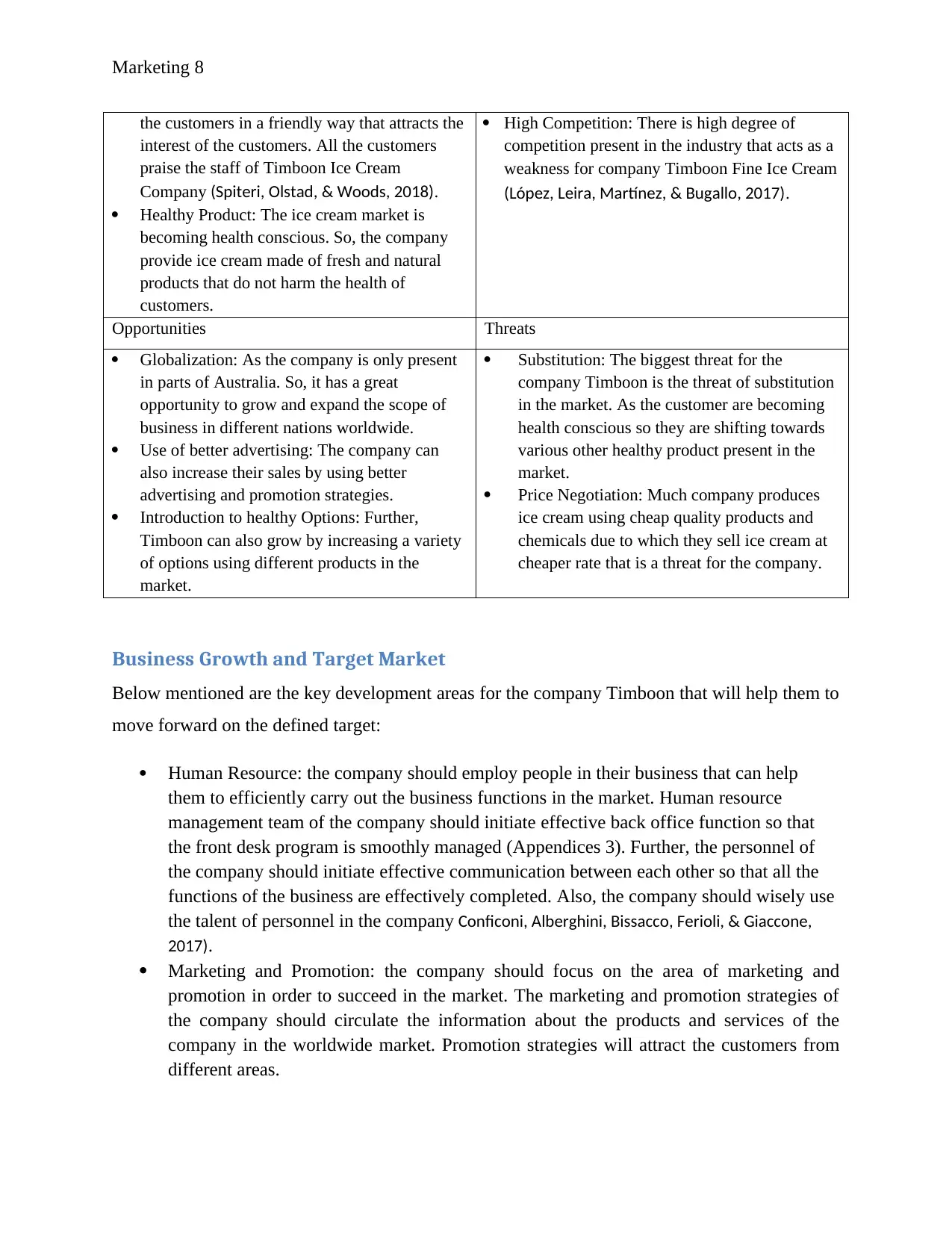
Marketing 8
the customers in a friendly way that attracts the
interest of the customers. All the customers
praise the staff of Timboon Ice Cream
Company (Spiteri, Olstad, & Woods, 2018).
Healthy Product: The ice cream market is
becoming health conscious. So, the company
provide ice cream made of fresh and natural
products that do not harm the health of
customers.
High Competition: There is high degree of
competition present in the industry that acts as a
weakness for company Timboon Fine Ice Cream
(López, Leira, Martínez, & Bugallo, 2017).
Opportunities Threats
Globalization: As the company is only present
in parts of Australia. So, it has a great
opportunity to grow and expand the scope of
business in different nations worldwide.
Use of better advertising: The company can
also increase their sales by using better
advertising and promotion strategies.
Introduction to healthy Options: Further,
Timboon can also grow by increasing a variety
of options using different products in the
market.
Substitution: The biggest threat for the
company Timboon is the threat of substitution
in the market. As the customer are becoming
health conscious so they are shifting towards
various other healthy product present in the
market.
Price Negotiation: Much company produces
ice cream using cheap quality products and
chemicals due to which they sell ice cream at
cheaper rate that is a threat for the company.
Business Growth and Target Market
Below mentioned are the key development areas for the company Timboon that will help them to
move forward on the defined target:
Human Resource: the company should employ people in their business that can help
them to efficiently carry out the business functions in the market. Human resource
management team of the company should initiate effective back office function so that
the front desk program is smoothly managed (Appendices 3). Further, the personnel of
the company should initiate effective communication between each other so that all the
functions of the business are effectively completed. Also, the company should wisely use
the talent of personnel in the company Conficoni, Alberghini, Bissacco, Ferioli, & Giaccone,
2017).
Marketing and Promotion: the company should focus on the area of marketing and
promotion in order to succeed in the market. The marketing and promotion strategies of
the company should circulate the information about the products and services of the
company in the worldwide market. Promotion strategies will attract the customers from
different areas.
the customers in a friendly way that attracts the
interest of the customers. All the customers
praise the staff of Timboon Ice Cream
Company (Spiteri, Olstad, & Woods, 2018).
Healthy Product: The ice cream market is
becoming health conscious. So, the company
provide ice cream made of fresh and natural
products that do not harm the health of
customers.
High Competition: There is high degree of
competition present in the industry that acts as a
weakness for company Timboon Fine Ice Cream
(López, Leira, Martínez, & Bugallo, 2017).
Opportunities Threats
Globalization: As the company is only present
in parts of Australia. So, it has a great
opportunity to grow and expand the scope of
business in different nations worldwide.
Use of better advertising: The company can
also increase their sales by using better
advertising and promotion strategies.
Introduction to healthy Options: Further,
Timboon can also grow by increasing a variety
of options using different products in the
market.
Substitution: The biggest threat for the
company Timboon is the threat of substitution
in the market. As the customer are becoming
health conscious so they are shifting towards
various other healthy product present in the
market.
Price Negotiation: Much company produces
ice cream using cheap quality products and
chemicals due to which they sell ice cream at
cheaper rate that is a threat for the company.
Business Growth and Target Market
Below mentioned are the key development areas for the company Timboon that will help them to
move forward on the defined target:
Human Resource: the company should employ people in their business that can help
them to efficiently carry out the business functions in the market. Human resource
management team of the company should initiate effective back office function so that
the front desk program is smoothly managed (Appendices 3). Further, the personnel of
the company should initiate effective communication between each other so that all the
functions of the business are effectively completed. Also, the company should wisely use
the talent of personnel in the company Conficoni, Alberghini, Bissacco, Ferioli, & Giaccone,
2017).
Marketing and Promotion: the company should focus on the area of marketing and
promotion in order to succeed in the market. The marketing and promotion strategies of
the company should circulate the information about the products and services of the
company in the worldwide market. Promotion strategies will attract the customers from
different areas.
⊘ This is a preview!⊘
Do you want full access?
Subscribe today to unlock all pages.

Trusted by 1+ million students worldwide
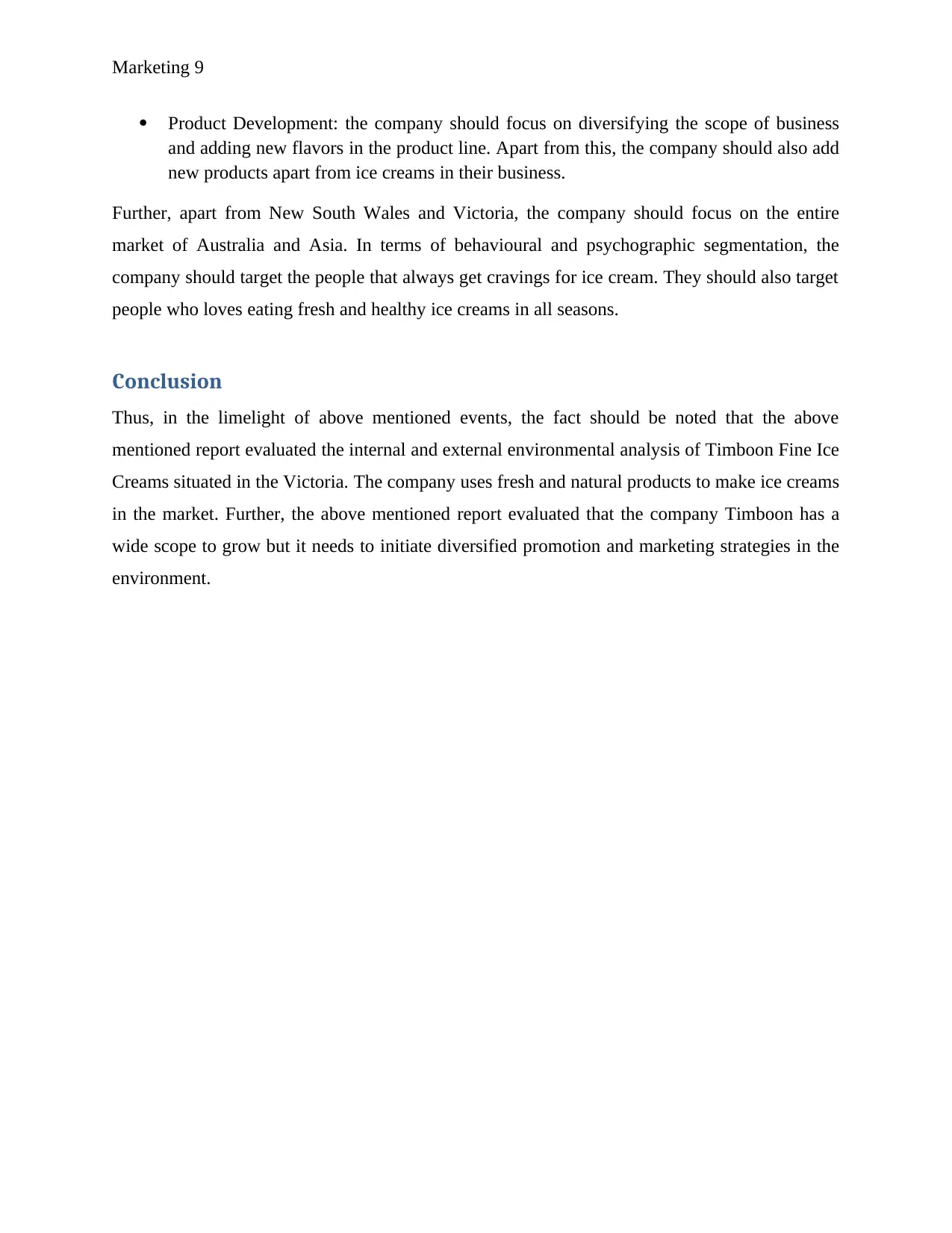
Marketing 9
Product Development: the company should focus on diversifying the scope of business
and adding new flavors in the product line. Apart from this, the company should also add
new products apart from ice creams in their business.
Further, apart from New South Wales and Victoria, the company should focus on the entire
market of Australia and Asia. In terms of behavioural and psychographic segmentation, the
company should target the people that always get cravings for ice cream. They should also target
people who loves eating fresh and healthy ice creams in all seasons.
Conclusion
Thus, in the limelight of above mentioned events, the fact should be noted that the above
mentioned report evaluated the internal and external environmental analysis of Timboon Fine Ice
Creams situated in the Victoria. The company uses fresh and natural products to make ice creams
in the market. Further, the above mentioned report evaluated that the company Timboon has a
wide scope to grow but it needs to initiate diversified promotion and marketing strategies in the
environment.
Product Development: the company should focus on diversifying the scope of business
and adding new flavors in the product line. Apart from this, the company should also add
new products apart from ice creams in their business.
Further, apart from New South Wales and Victoria, the company should focus on the entire
market of Australia and Asia. In terms of behavioural and psychographic segmentation, the
company should target the people that always get cravings for ice cream. They should also target
people who loves eating fresh and healthy ice creams in all seasons.
Conclusion
Thus, in the limelight of above mentioned events, the fact should be noted that the above
mentioned report evaluated the internal and external environmental analysis of Timboon Fine Ice
Creams situated in the Victoria. The company uses fresh and natural products to make ice creams
in the market. Further, the above mentioned report evaluated that the company Timboon has a
wide scope to grow but it needs to initiate diversified promotion and marketing strategies in the
environment.
Paraphrase This Document
Need a fresh take? Get an instant paraphrase of this document with our AI Paraphraser
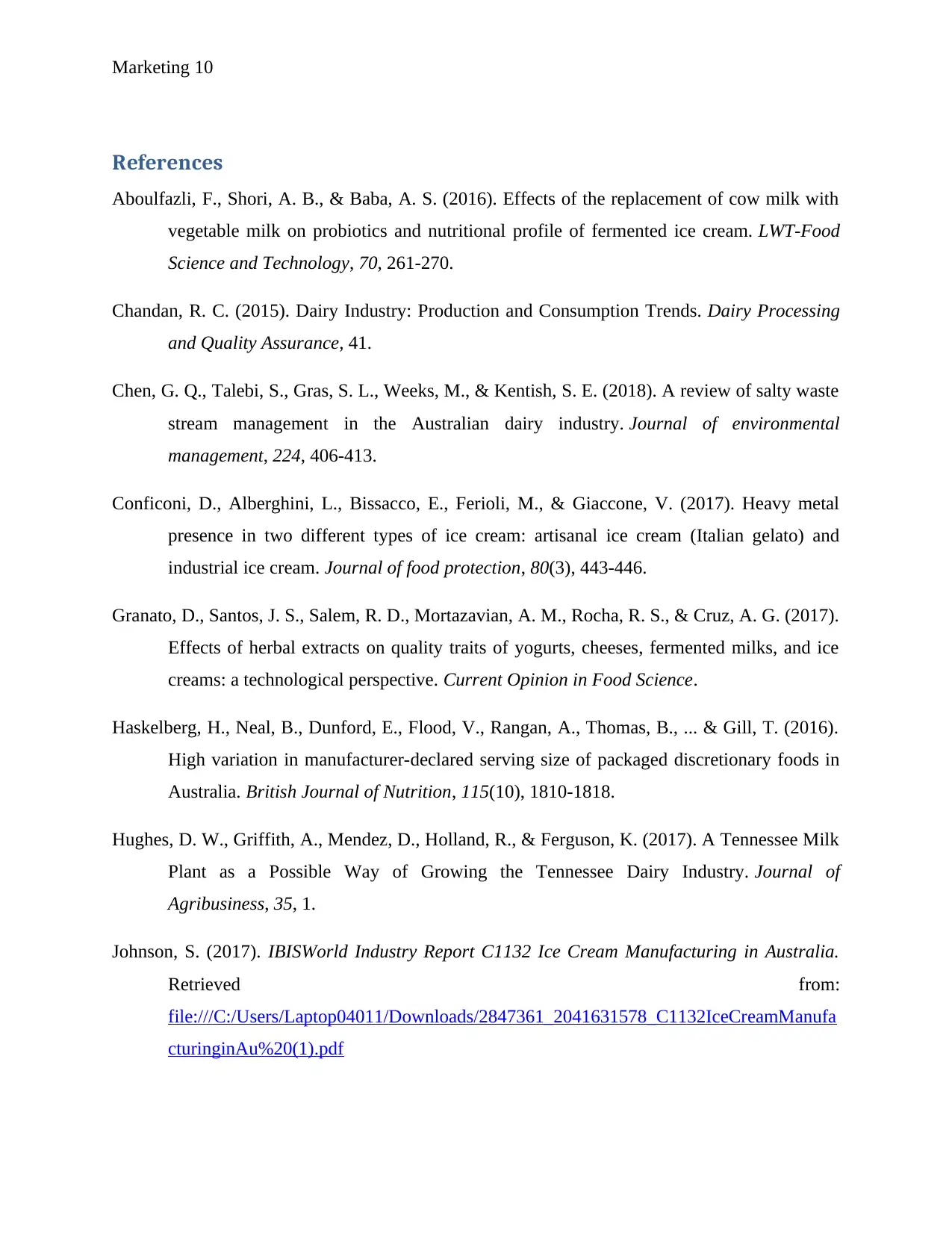
Marketing 10
References
Aboulfazli, F., Shori, A. B., & Baba, A. S. (2016). Effects of the replacement of cow milk with
vegetable milk on probiotics and nutritional profile of fermented ice cream. LWT-Food
Science and Technology, 70, 261-270.
Chandan, R. C. (2015). Dairy Industry: Production and Consumption Trends. Dairy Processing
and Quality Assurance, 41.
Chen, G. Q., Talebi, S., Gras, S. L., Weeks, M., & Kentish, S. E. (2018). A review of salty waste
stream management in the Australian dairy industry. Journal of environmental
management, 224, 406-413.
Conficoni, D., Alberghini, L., Bissacco, E., Ferioli, M., & Giaccone, V. (2017). Heavy metal
presence in two different types of ice cream: artisanal ice cream (Italian gelato) and
industrial ice cream. Journal of food protection, 80(3), 443-446.
Granato, D., Santos, J. S., Salem, R. D., Mortazavian, A. M., Rocha, R. S., & Cruz, A. G. (2017).
Effects of herbal extracts on quality traits of yogurts, cheeses, fermented milks, and ice
creams: a technological perspective. Current Opinion in Food Science.
Haskelberg, H., Neal, B., Dunford, E., Flood, V., Rangan, A., Thomas, B., ... & Gill, T. (2016).
High variation in manufacturer-declared serving size of packaged discretionary foods in
Australia. British Journal of Nutrition, 115(10), 1810-1818.
Hughes, D. W., Griffith, A., Mendez, D., Holland, R., & Ferguson, K. (2017). A Tennessee Milk
Plant as a Possible Way of Growing the Tennessee Dairy Industry. Journal of
Agribusiness, 35, 1.
Johnson, S. (2017). IBISWorld Industry Report C1132 Ice Cream Manufacturing in Australia.
Retrieved from:
file:///C:/Users/Laptop04011/Downloads/2847361_2041631578_C1132IceCreamManufa
cturinginAu%20(1).pdf
References
Aboulfazli, F., Shori, A. B., & Baba, A. S. (2016). Effects of the replacement of cow milk with
vegetable milk on probiotics and nutritional profile of fermented ice cream. LWT-Food
Science and Technology, 70, 261-270.
Chandan, R. C. (2015). Dairy Industry: Production and Consumption Trends. Dairy Processing
and Quality Assurance, 41.
Chen, G. Q., Talebi, S., Gras, S. L., Weeks, M., & Kentish, S. E. (2018). A review of salty waste
stream management in the Australian dairy industry. Journal of environmental
management, 224, 406-413.
Conficoni, D., Alberghini, L., Bissacco, E., Ferioli, M., & Giaccone, V. (2017). Heavy metal
presence in two different types of ice cream: artisanal ice cream (Italian gelato) and
industrial ice cream. Journal of food protection, 80(3), 443-446.
Granato, D., Santos, J. S., Salem, R. D., Mortazavian, A. M., Rocha, R. S., & Cruz, A. G. (2017).
Effects of herbal extracts on quality traits of yogurts, cheeses, fermented milks, and ice
creams: a technological perspective. Current Opinion in Food Science.
Haskelberg, H., Neal, B., Dunford, E., Flood, V., Rangan, A., Thomas, B., ... & Gill, T. (2016).
High variation in manufacturer-declared serving size of packaged discretionary foods in
Australia. British Journal of Nutrition, 115(10), 1810-1818.
Hughes, D. W., Griffith, A., Mendez, D., Holland, R., & Ferguson, K. (2017). A Tennessee Milk
Plant as a Possible Way of Growing the Tennessee Dairy Industry. Journal of
Agribusiness, 35, 1.
Johnson, S. (2017). IBISWorld Industry Report C1132 Ice Cream Manufacturing in Australia.
Retrieved from:
file:///C:/Users/Laptop04011/Downloads/2847361_2041631578_C1132IceCreamManufa
cturinginAu%20(1).pdf
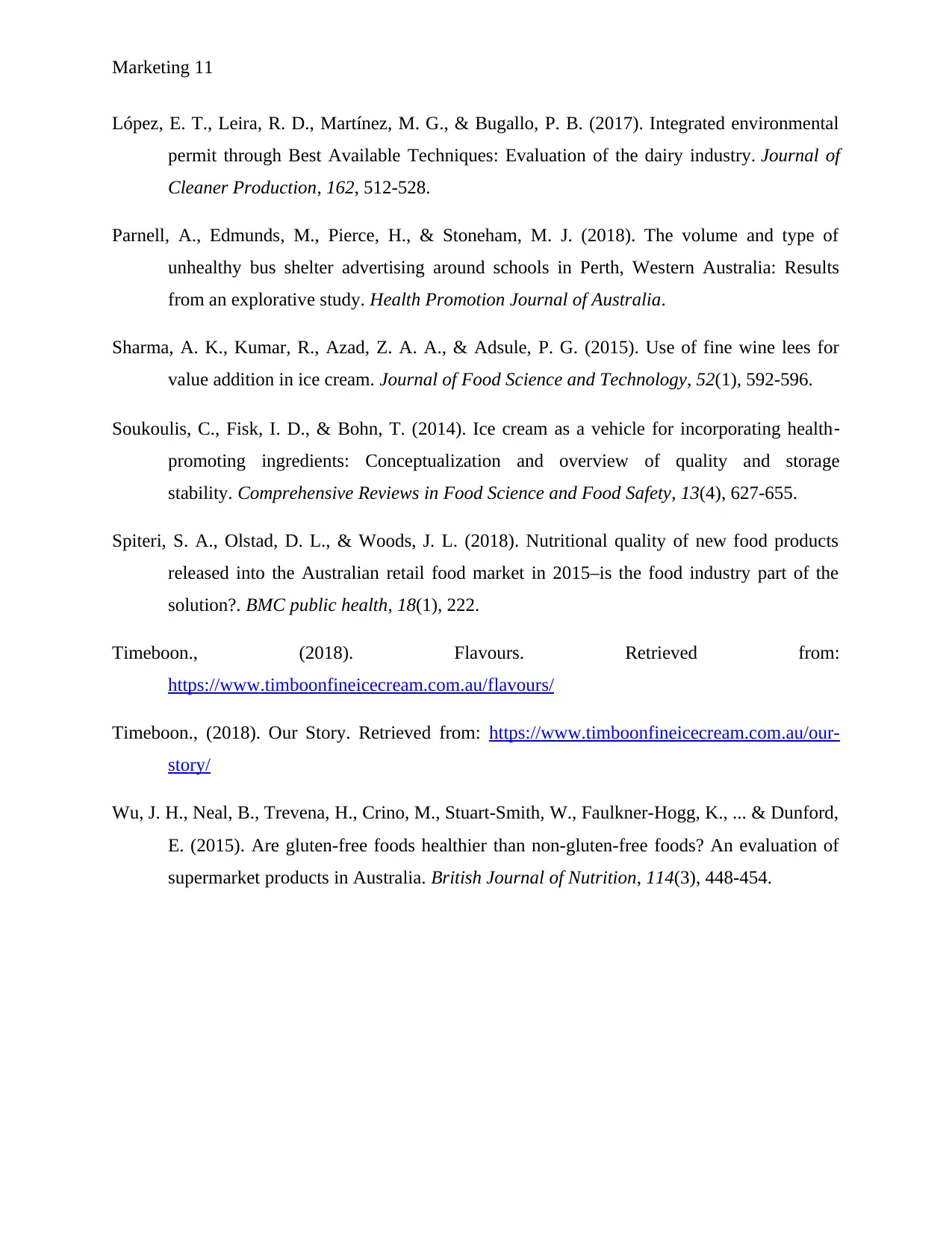
Marketing 11
López, E. T., Leira, R. D., Martínez, M. G., & Bugallo, P. B. (2017). Integrated environmental
permit through Best Available Techniques: Evaluation of the dairy industry. Journal of
Cleaner Production, 162, 512-528.
Parnell, A., Edmunds, M., Pierce, H., & Stoneham, M. J. (2018). The volume and type of
unhealthy bus shelter advertising around schools in Perth, Western Australia: Results
from an explorative study. Health Promotion Journal of Australia.
Sharma, A. K., Kumar, R., Azad, Z. A. A., & Adsule, P. G. (2015). Use of fine wine lees for
value addition in ice cream. Journal of Food Science and Technology, 52(1), 592-596.
Soukoulis, C., Fisk, I. D., & Bohn, T. (2014). Ice cream as a vehicle for incorporating health‐
promoting ingredients: Conceptualization and overview of quality and storage
stability. Comprehensive Reviews in Food Science and Food Safety, 13(4), 627-655.
Spiteri, S. A., Olstad, D. L., & Woods, J. L. (2018). Nutritional quality of new food products
released into the Australian retail food market in 2015–is the food industry part of the
solution?. BMC public health, 18(1), 222.
Timeboon., (2018). Flavours. Retrieved from:
https://www.timboonfineicecream.com.au/flavours/
Timeboon., (2018). Our Story. Retrieved from: https://www.timboonfineicecream.com.au/our-
story/
Wu, J. H., Neal, B., Trevena, H., Crino, M., Stuart-Smith, W., Faulkner-Hogg, K., ... & Dunford,
E. (2015). Are gluten-free foods healthier than non-gluten-free foods? An evaluation of
supermarket products in Australia. British Journal of Nutrition, 114(3), 448-454.
López, E. T., Leira, R. D., Martínez, M. G., & Bugallo, P. B. (2017). Integrated environmental
permit through Best Available Techniques: Evaluation of the dairy industry. Journal of
Cleaner Production, 162, 512-528.
Parnell, A., Edmunds, M., Pierce, H., & Stoneham, M. J. (2018). The volume and type of
unhealthy bus shelter advertising around schools in Perth, Western Australia: Results
from an explorative study. Health Promotion Journal of Australia.
Sharma, A. K., Kumar, R., Azad, Z. A. A., & Adsule, P. G. (2015). Use of fine wine lees for
value addition in ice cream. Journal of Food Science and Technology, 52(1), 592-596.
Soukoulis, C., Fisk, I. D., & Bohn, T. (2014). Ice cream as a vehicle for incorporating health‐
promoting ingredients: Conceptualization and overview of quality and storage
stability. Comprehensive Reviews in Food Science and Food Safety, 13(4), 627-655.
Spiteri, S. A., Olstad, D. L., & Woods, J. L. (2018). Nutritional quality of new food products
released into the Australian retail food market in 2015–is the food industry part of the
solution?. BMC public health, 18(1), 222.
Timeboon., (2018). Flavours. Retrieved from:
https://www.timboonfineicecream.com.au/flavours/
Timeboon., (2018). Our Story. Retrieved from: https://www.timboonfineicecream.com.au/our-
story/
Wu, J. H., Neal, B., Trevena, H., Crino, M., Stuart-Smith, W., Faulkner-Hogg, K., ... & Dunford,
E. (2015). Are gluten-free foods healthier than non-gluten-free foods? An evaluation of
supermarket products in Australia. British Journal of Nutrition, 114(3), 448-454.
⊘ This is a preview!⊘
Do you want full access?
Subscribe today to unlock all pages.

Trusted by 1+ million students worldwide
1 out of 14
Related Documents
Your All-in-One AI-Powered Toolkit for Academic Success.
+13062052269
info@desklib.com
Available 24*7 on WhatsApp / Email
![[object Object]](/_next/static/media/star-bottom.7253800d.svg)
Unlock your academic potential
Copyright © 2020–2025 A2Z Services. All Rights Reserved. Developed and managed by ZUCOL.




